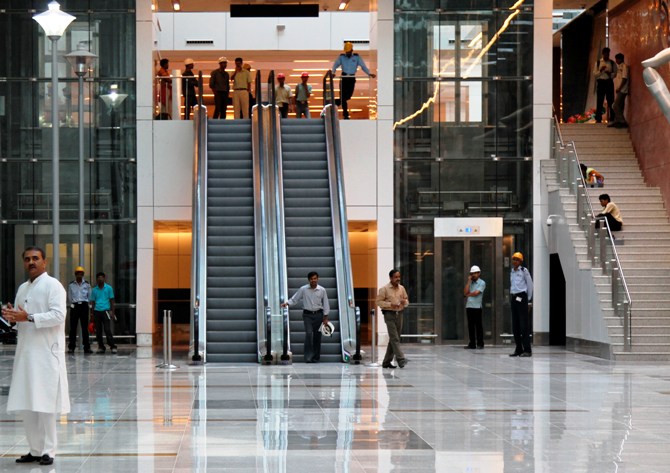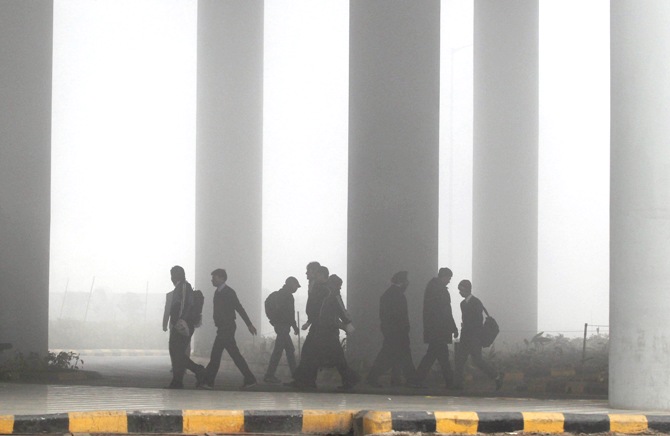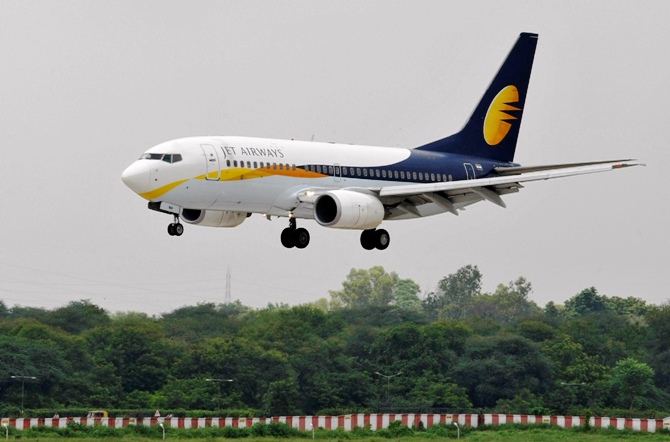Photographs: B Mathur/Reuters Sharmistha Mukherjee in New Delhi
To reduce delays during the coming fog season, the Airports Authority of India and Delhi International Airport have integrated collaborative decision-making procedure with each other.
CDM involves airport operators, airlines, ground handlers and air traffic control collaborating and sharing data through an automated system.
I Prabhakar Rao, chief executive, DIAL, said: “The combined decision-making will help in improved use of ATC resources, runways and taxiways, translating into less workload for controllers and minimum ground delays.
“Trained officers are also being deployed by AAI at our operational centre to work in close coordination with officers and airlines.”
. . .
AAI has a team plan to cut through fog
Image: Former Civil Aviation Minister Praful Patel is seen (L) during a visit to the newly constructed Terminal 3 at the Indira Gandhi International Airport in New Delhi in 2010.Photographs: B Mathur/Reuters
A senior AAI official said, “This (integration of CDM) will improve aircraft turnaround time and pre-departure sequence process, particularly after lifting of dense fog.”
The integration of CDM, together with prediction of better visibility conditions by the India Meteorological Department, is expected to result in minimum disruption of flights this fog season, said experts.
ATC data show on an average airport capacity falls 40 per cent because of higher runway occupation time during the dense fog period.
The Met department has predicted 80-100 hours of fog with 15-20 days of disruption at the Delhi airport, against the 140 fog hours recorded last year.
The department has also said dense fog onset of longer spell would be delayed and was likely to start from December 24-28.
. . .
AAI has a team plan to cut through fog
Image: Airport staff walk towards the main terminal amid heavy fog in New Delhi.Photographs: Adnan Abidi/Reuters
AAI officials said as far as possible, all the runways would be used during winter for smooth air traffic flow at the Delhi airport.
The three runways at the airport are certified for CAT-IIIB operations, allowing landing even if visibility is as low as 50 metres.
However, fog at the airports in the northern and eastern parts of the country delays flight operations, resulting in pileups.
These do not have an advanced instrument landing system like CAT-III and, hence, operations stop during dense fog.
. . .
AAI has a team plan to cut through fog
Image: A Jet Airways passenger aircraft prepares to land at the airport.Photographs: Amit Dave/Reuters
Data-link system
To ensure faster turnaround of delayed aircraft and less route congestion, AAI has implemented the data-link clearance delivery sytem.
At present, pilots obtain their pre-departure clearances from ATC through radio communication.
They then read back the entire clearance for confirmation, which takes a lot of time.
In the new system, pilots would request pre-departure clearance using the flight management computer in the cockpit.
The request will be transmitted via data-link to ATC, who will then message the clearance to the aircraft via data-link.
AAI has also identified 13 airports for posiible diversion of aircraft during fog and decided to accord priority to all diverted flights, while returning to the Delhi airport.






article